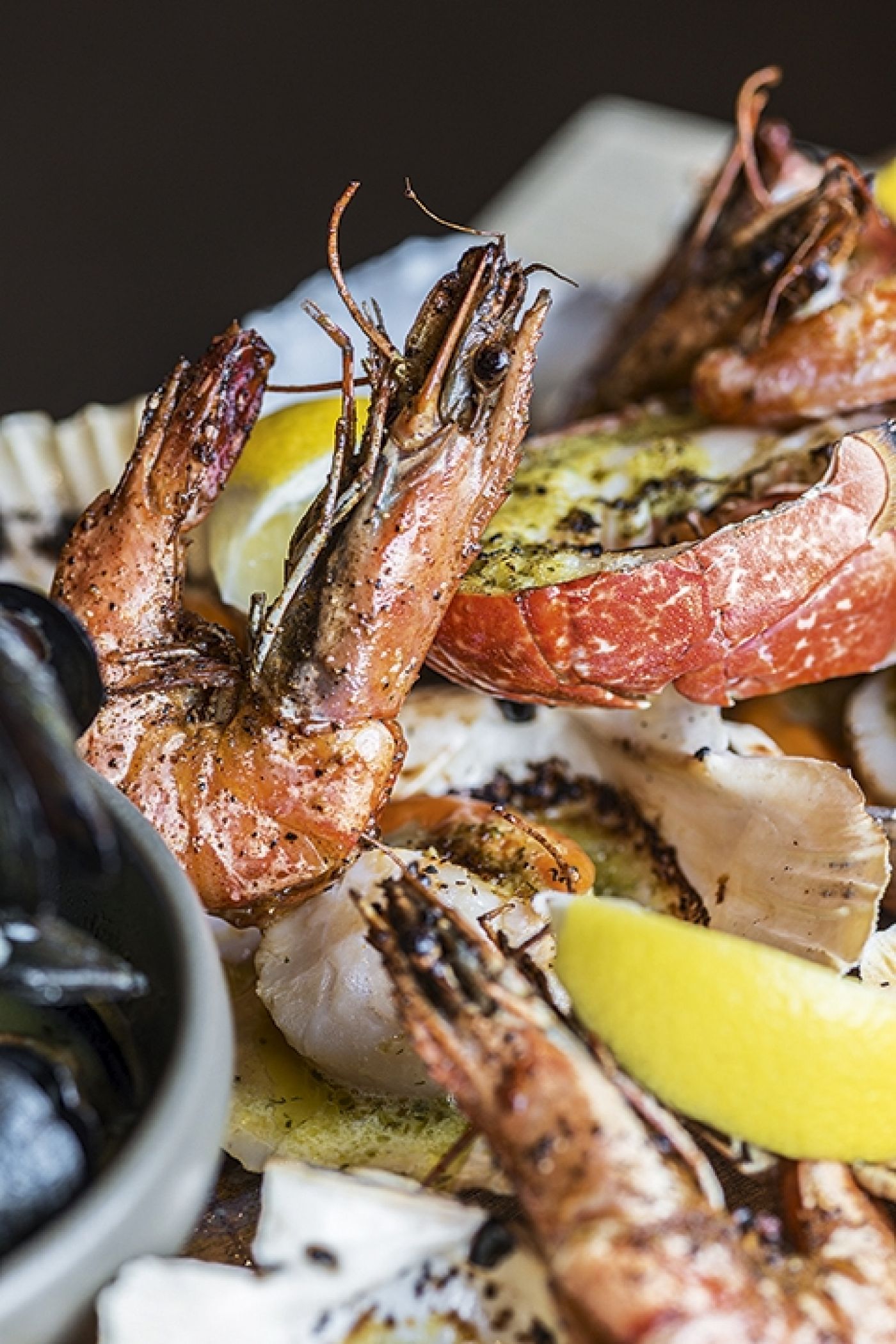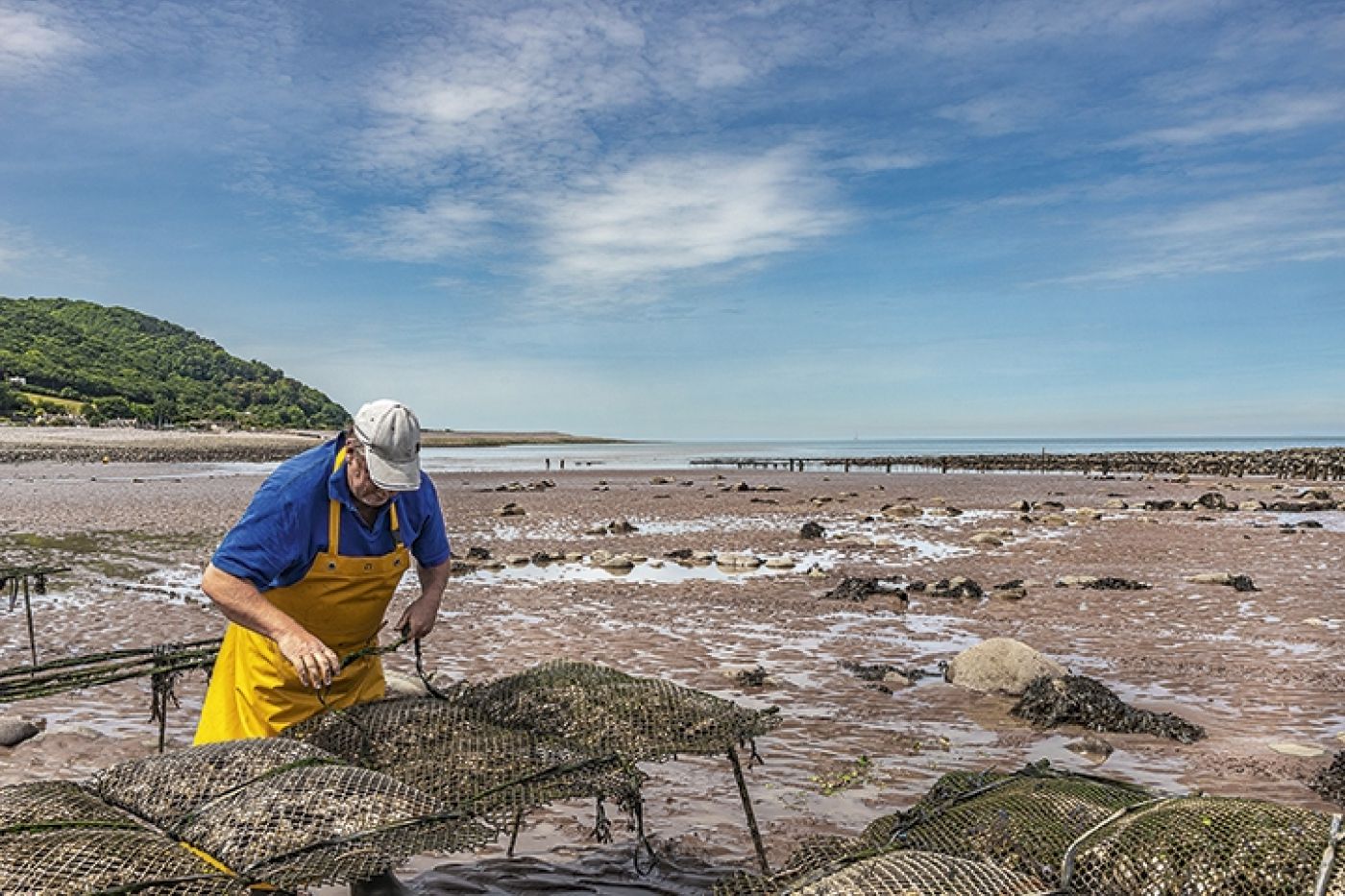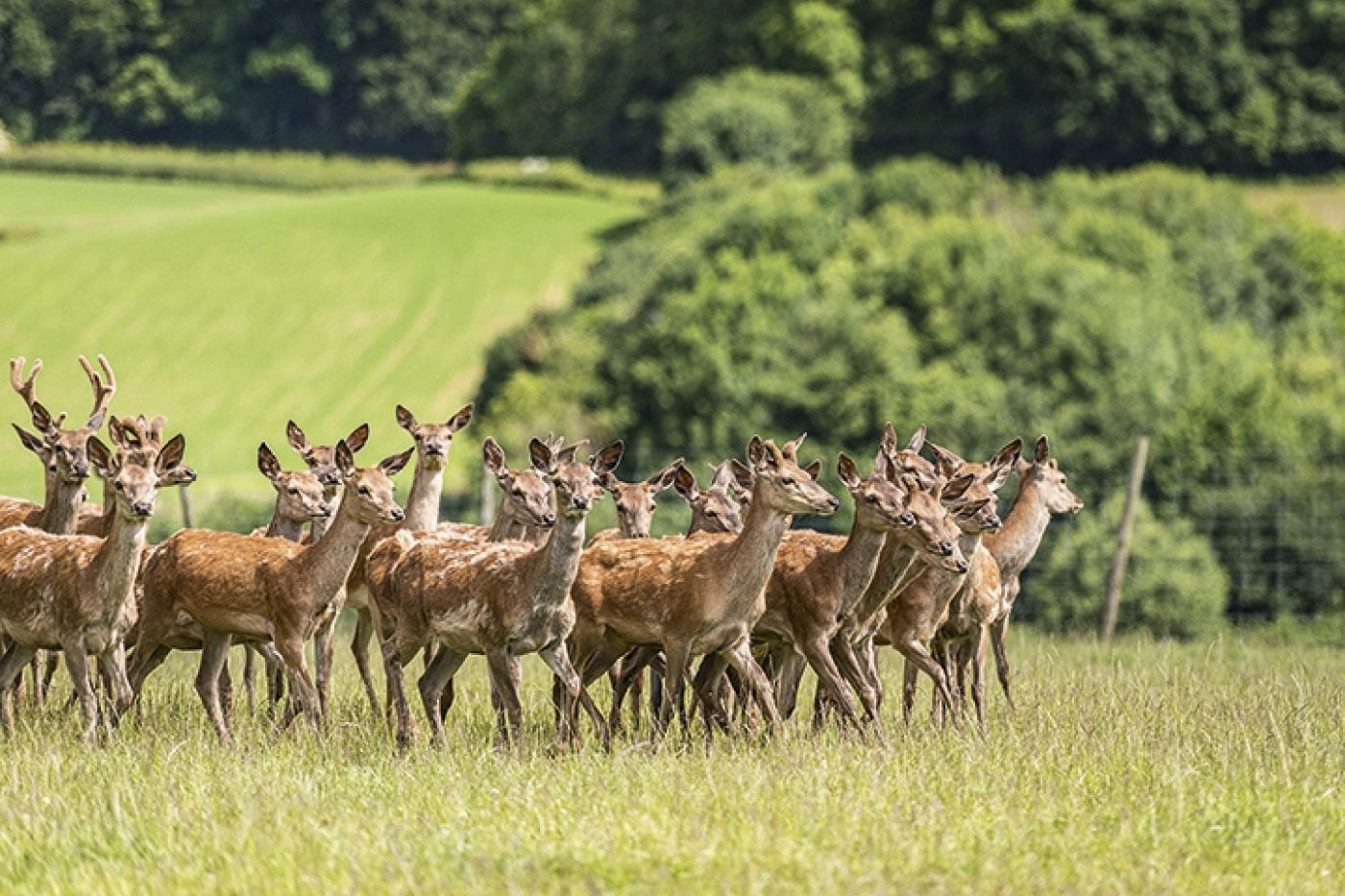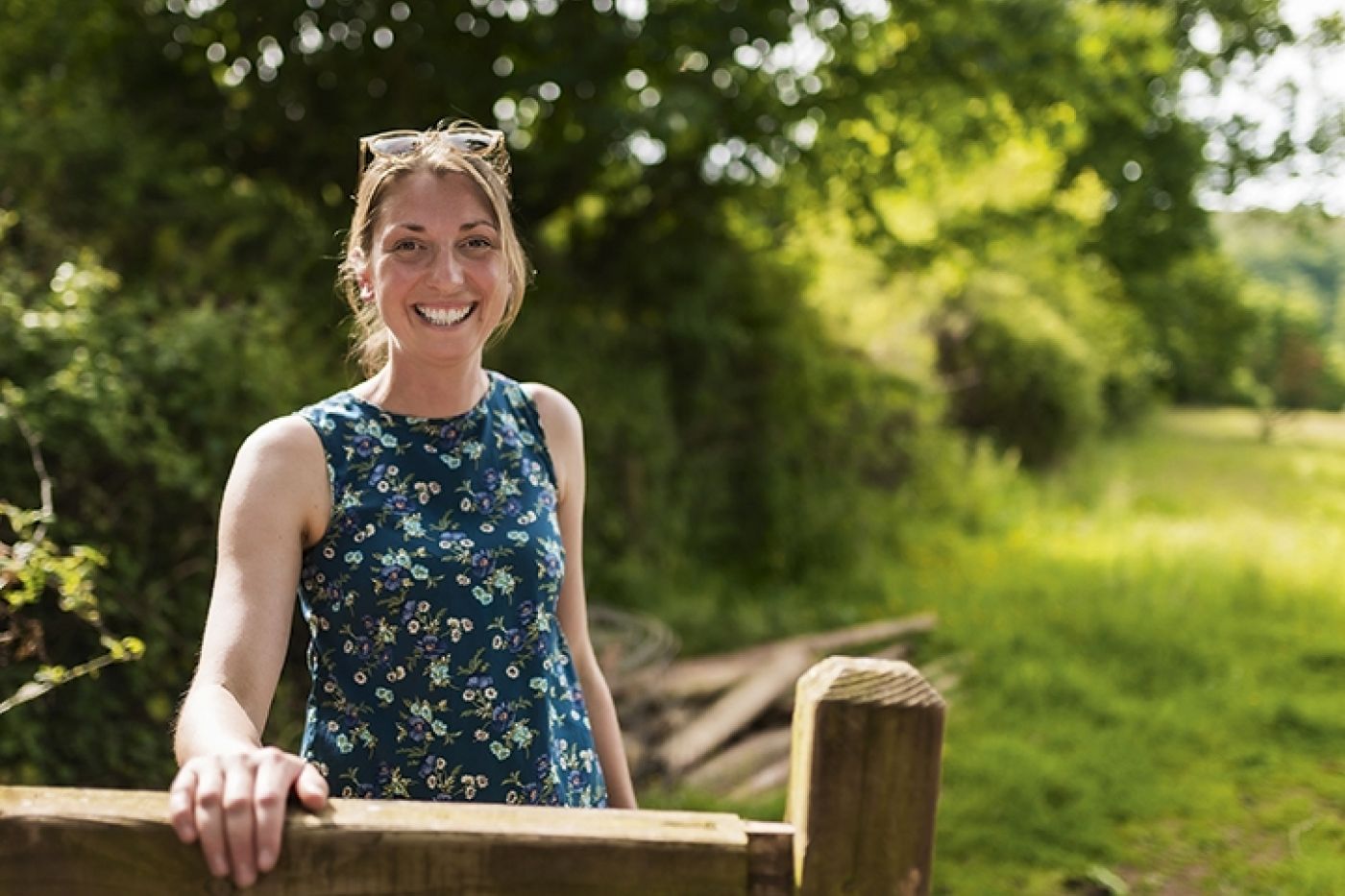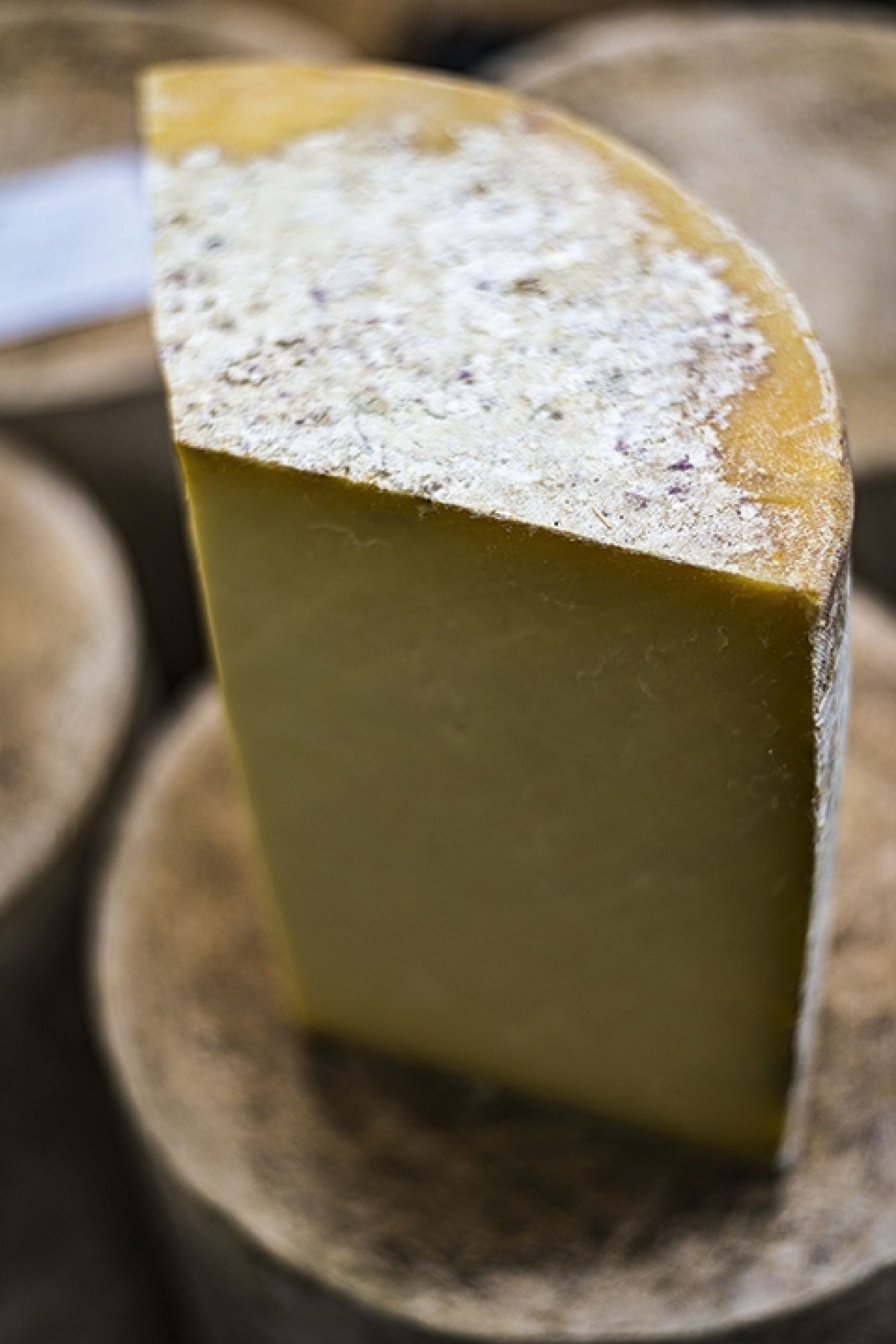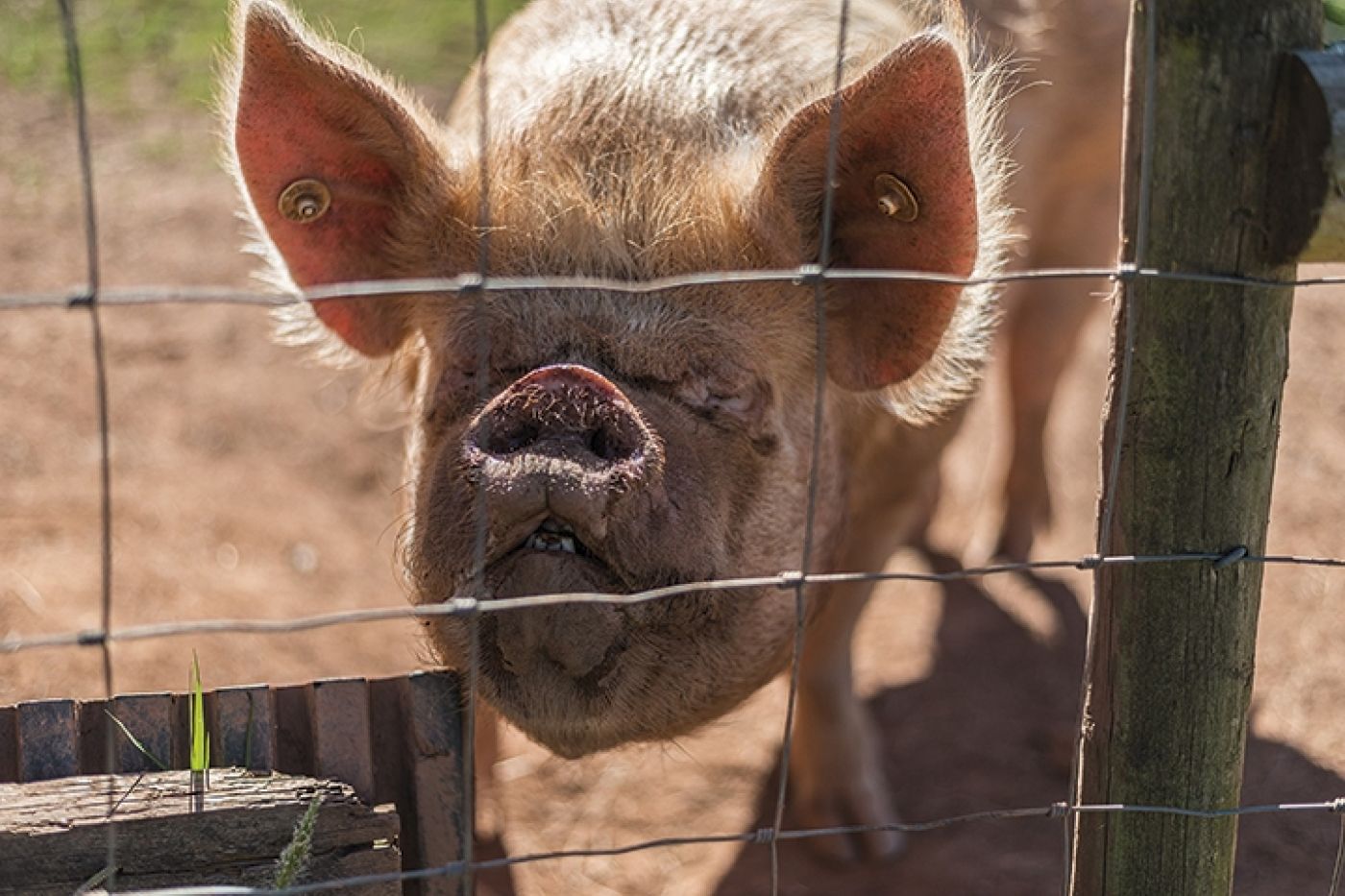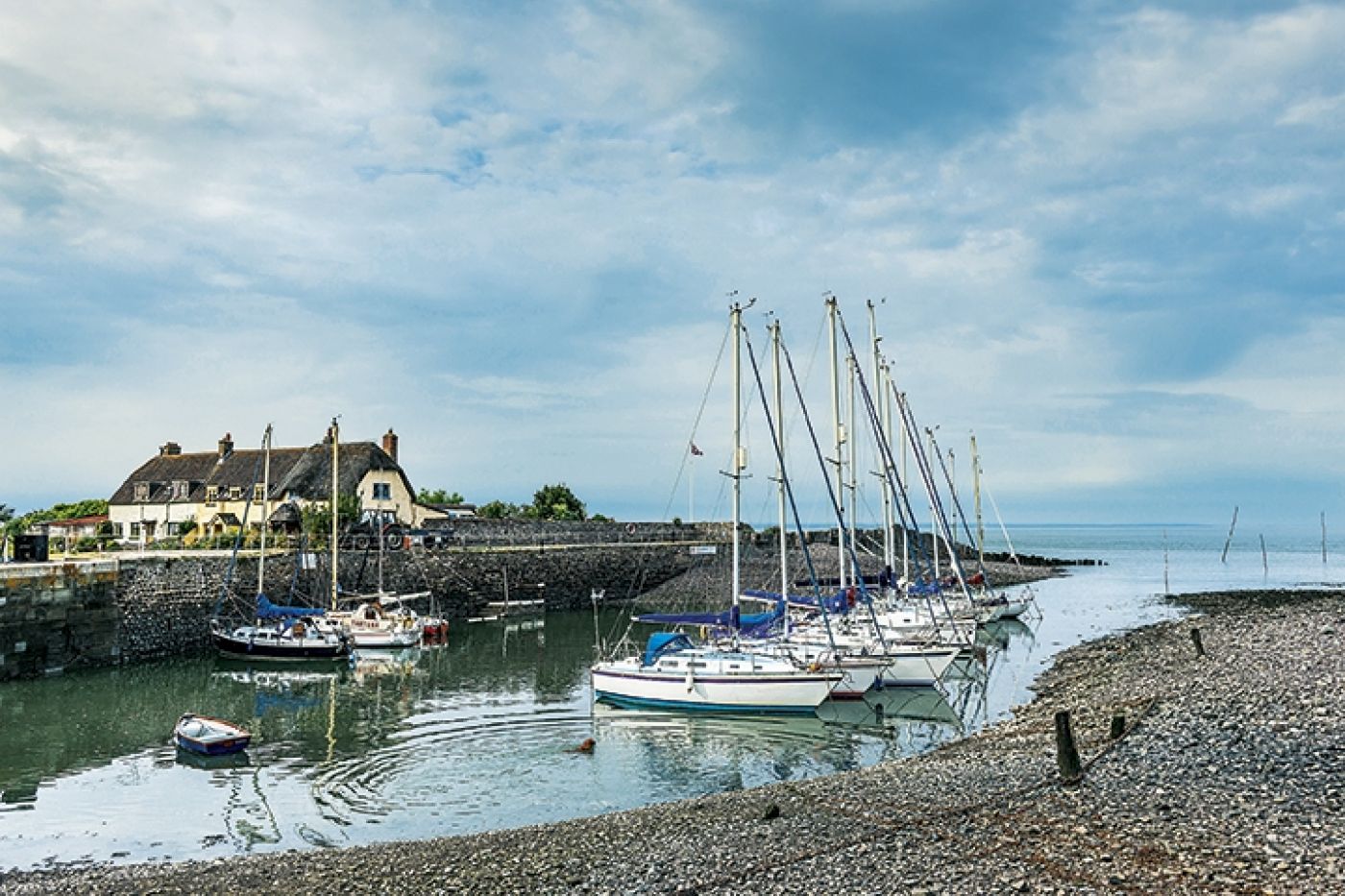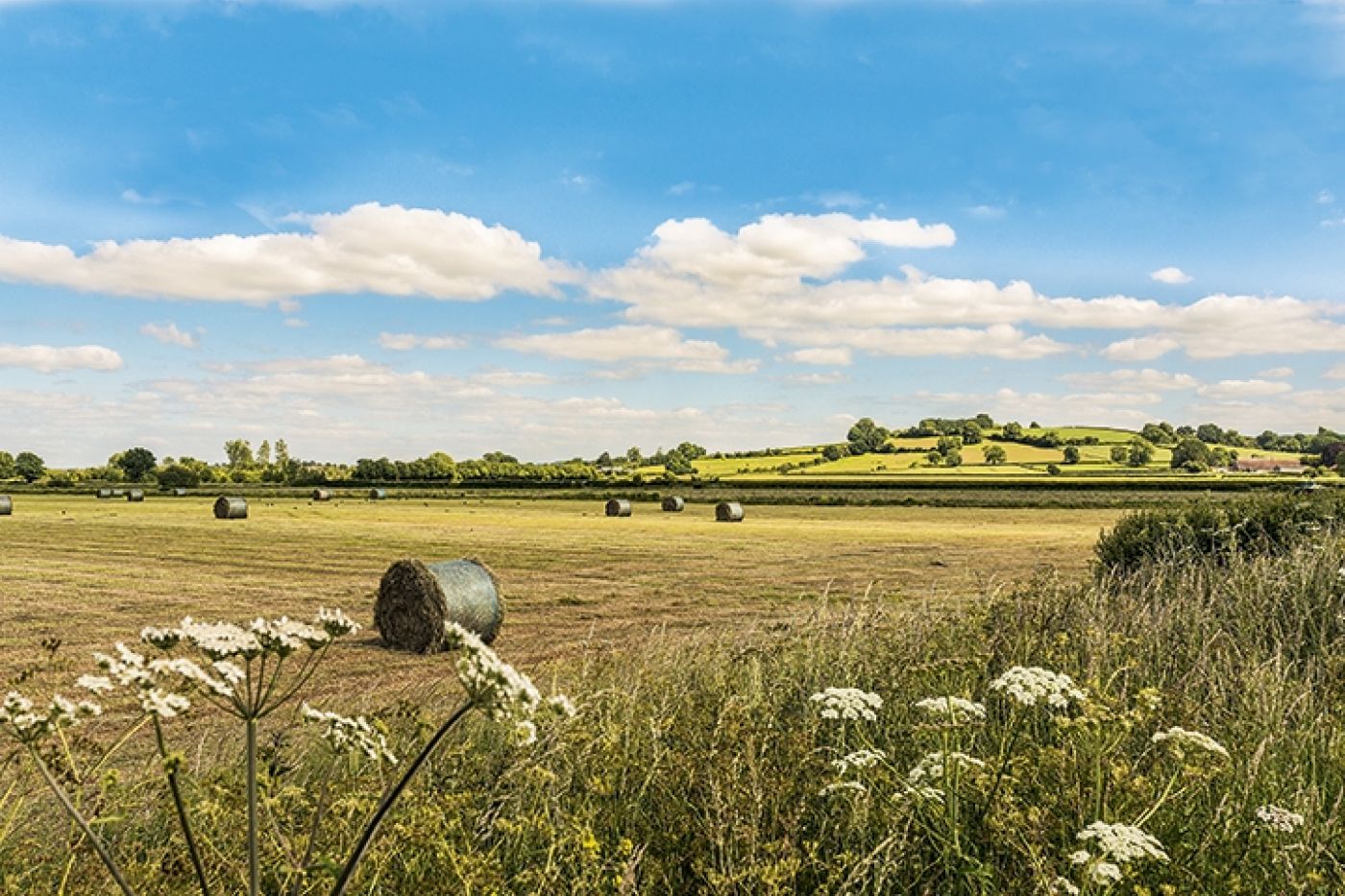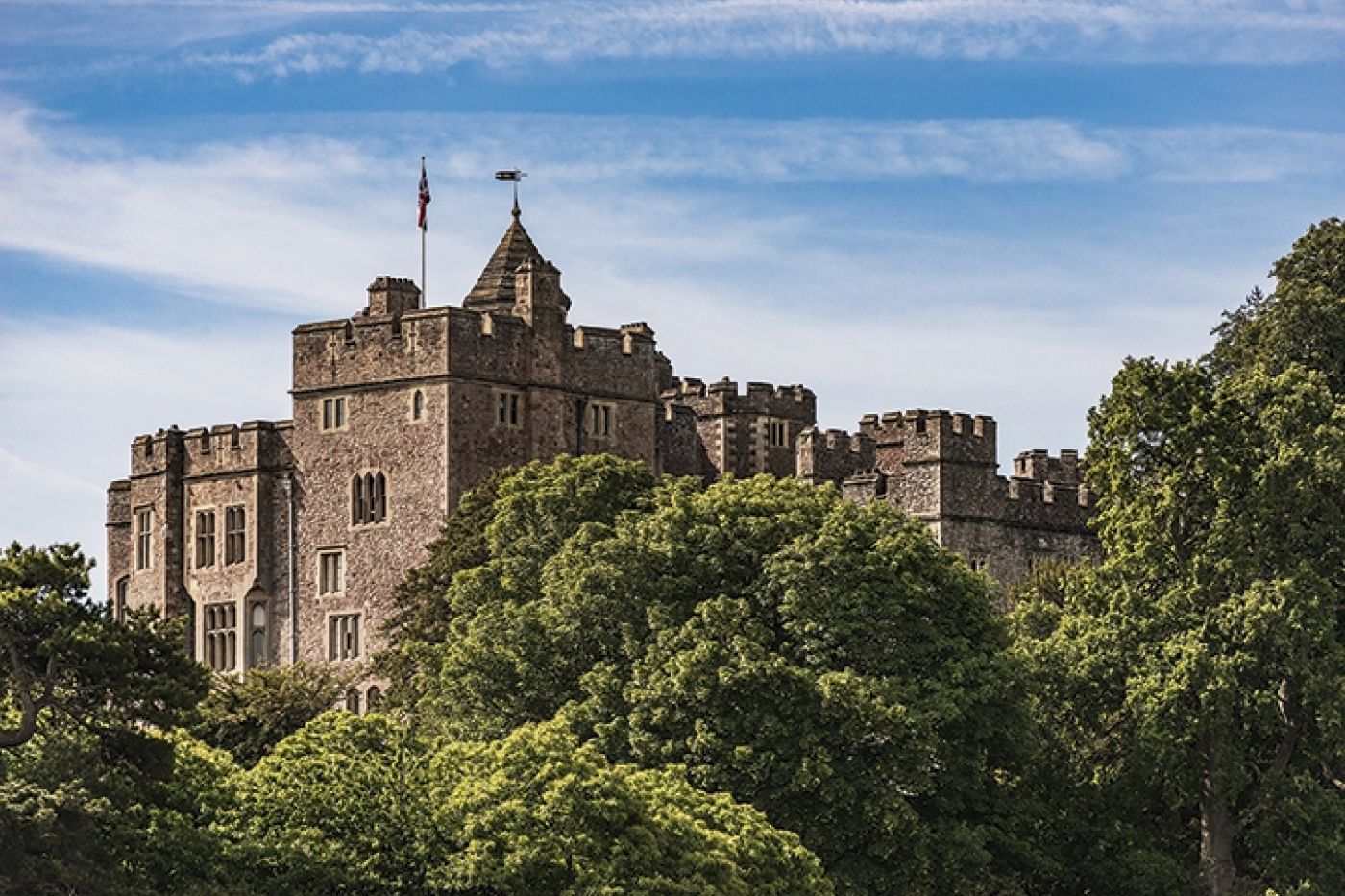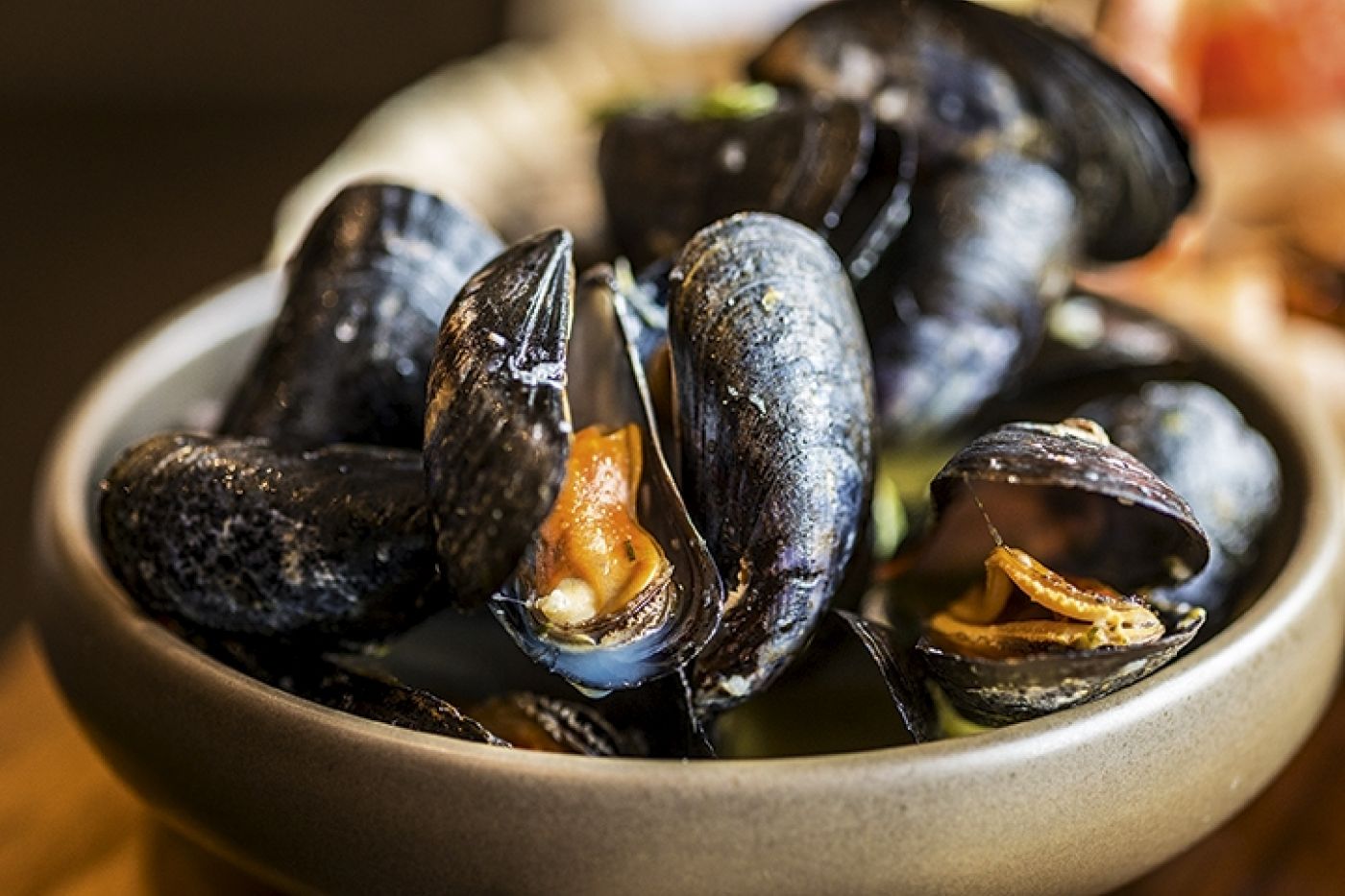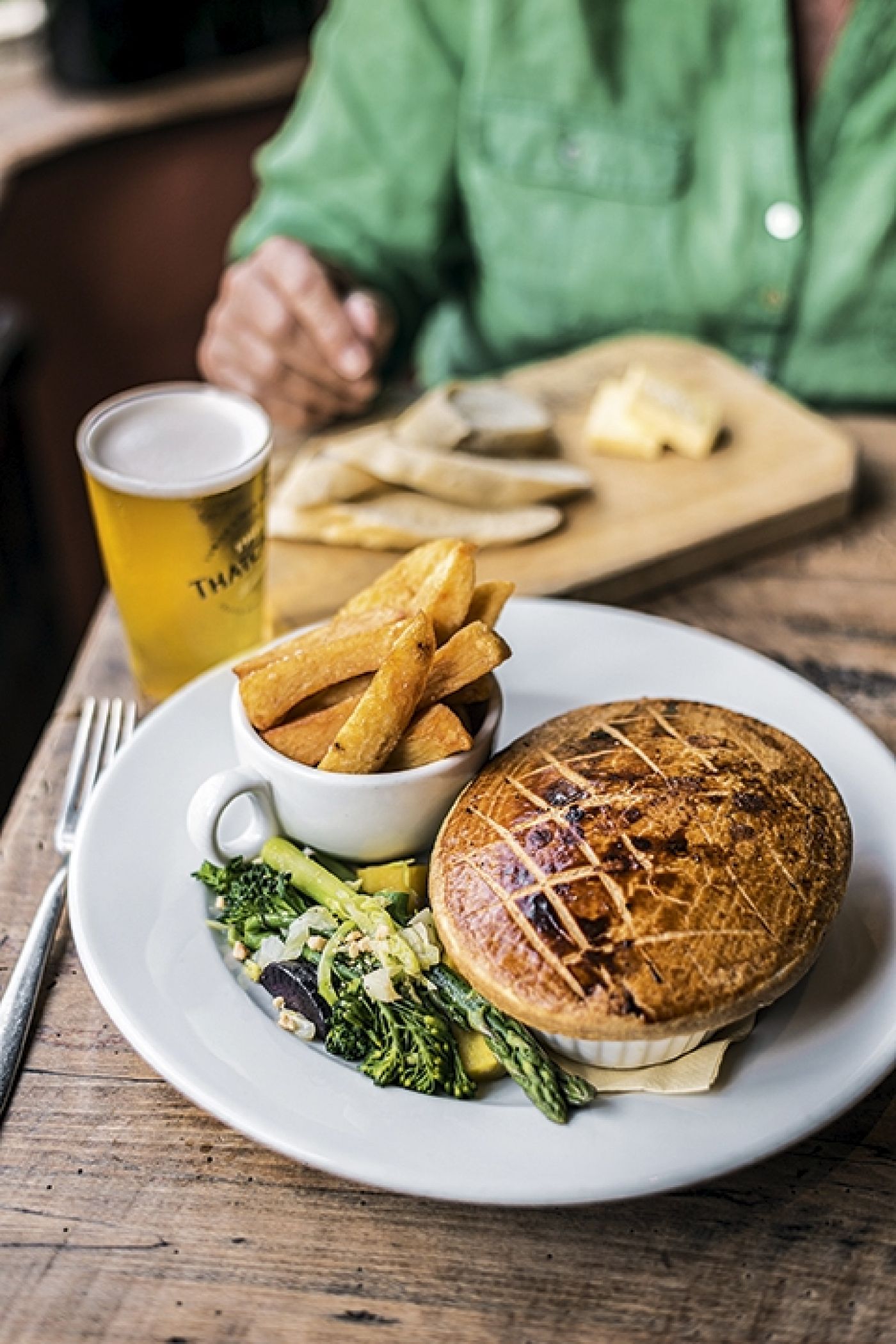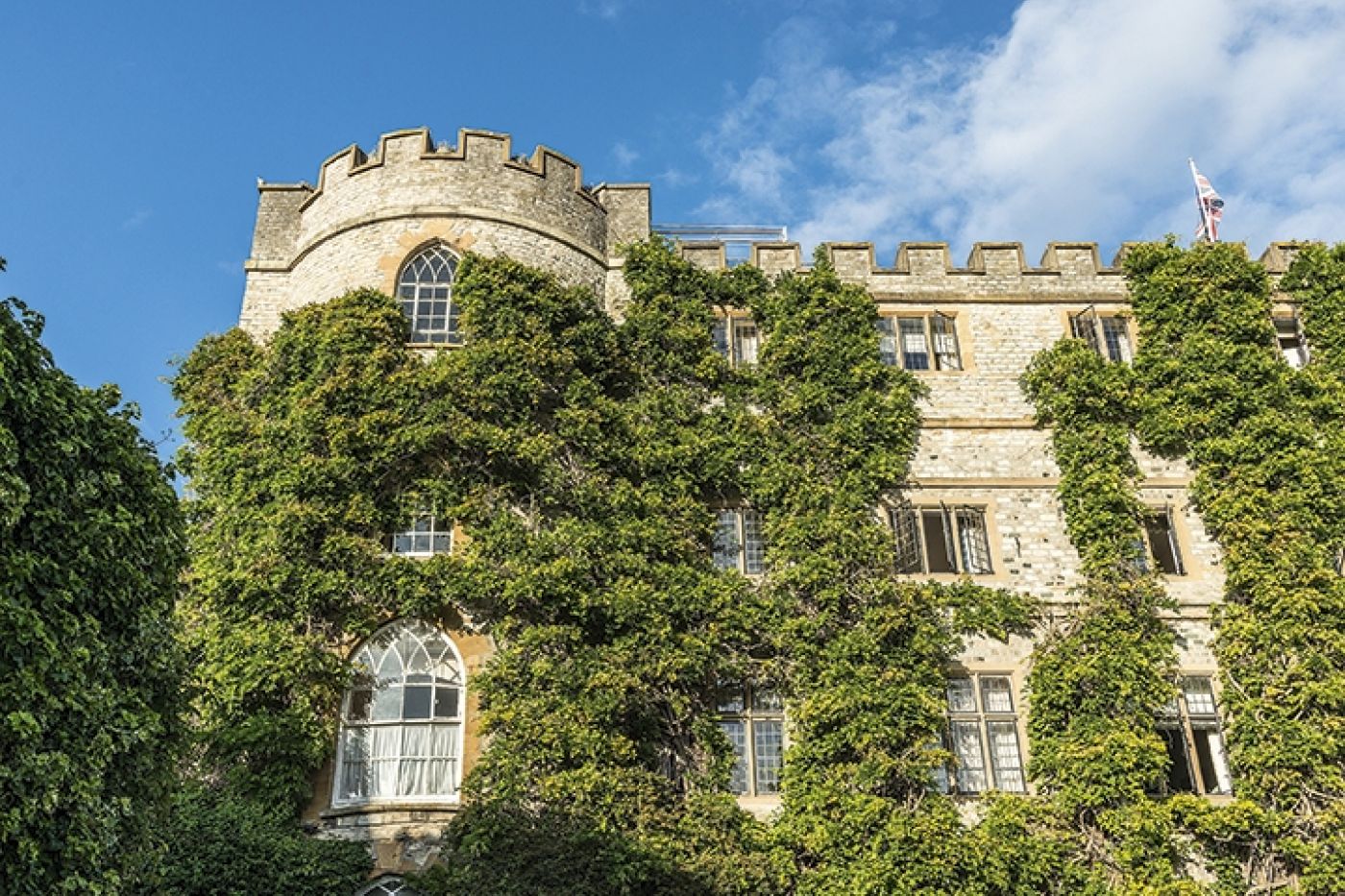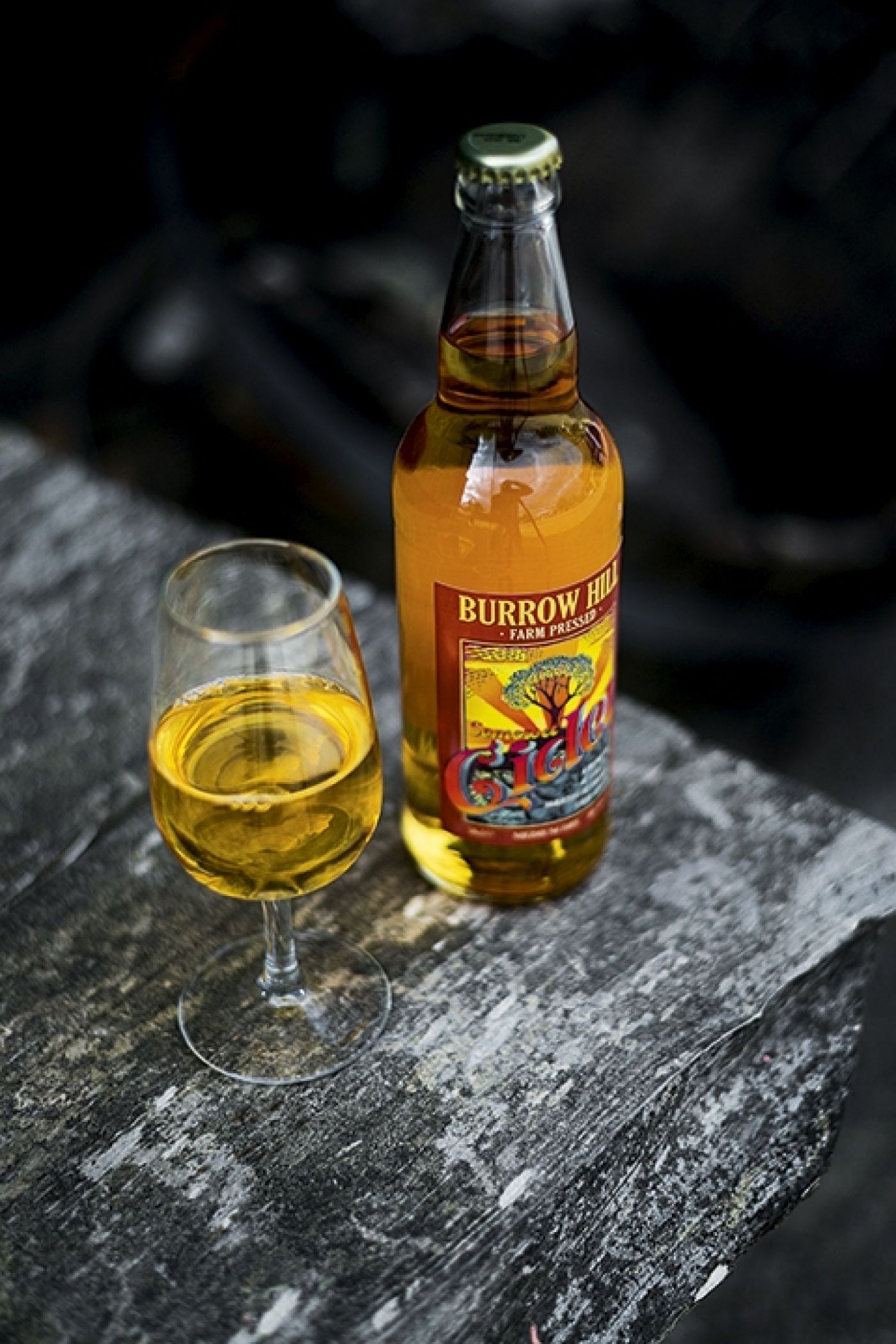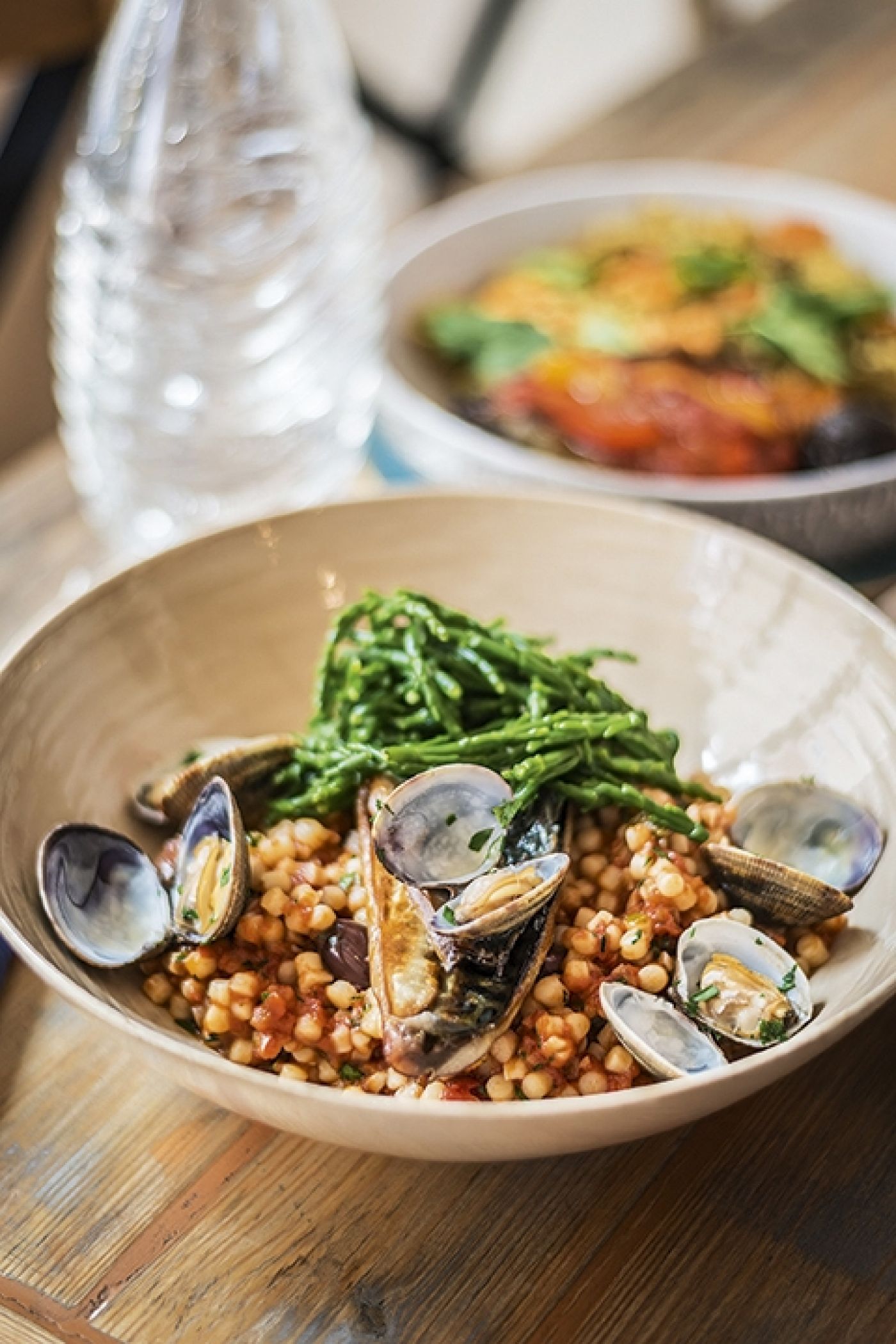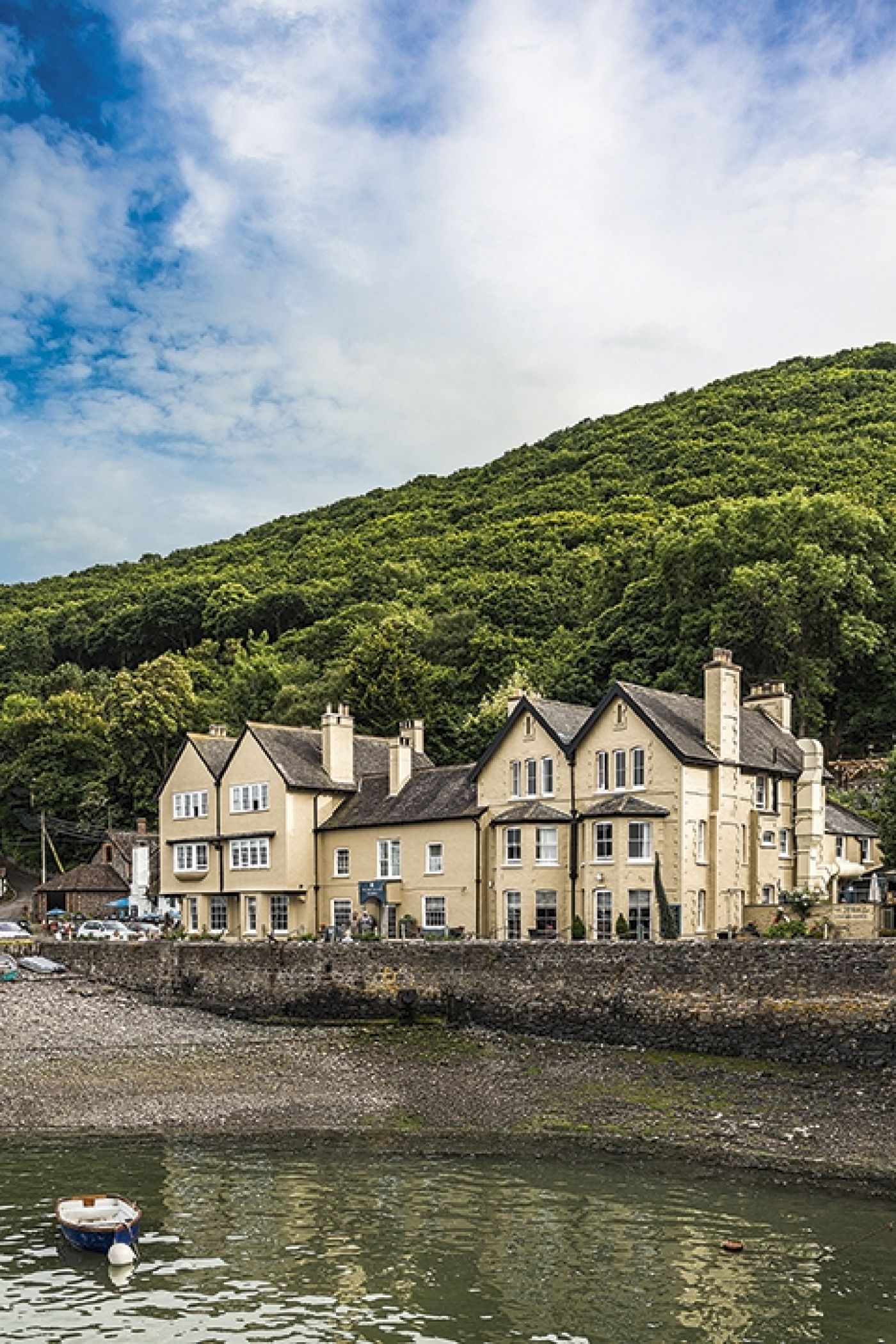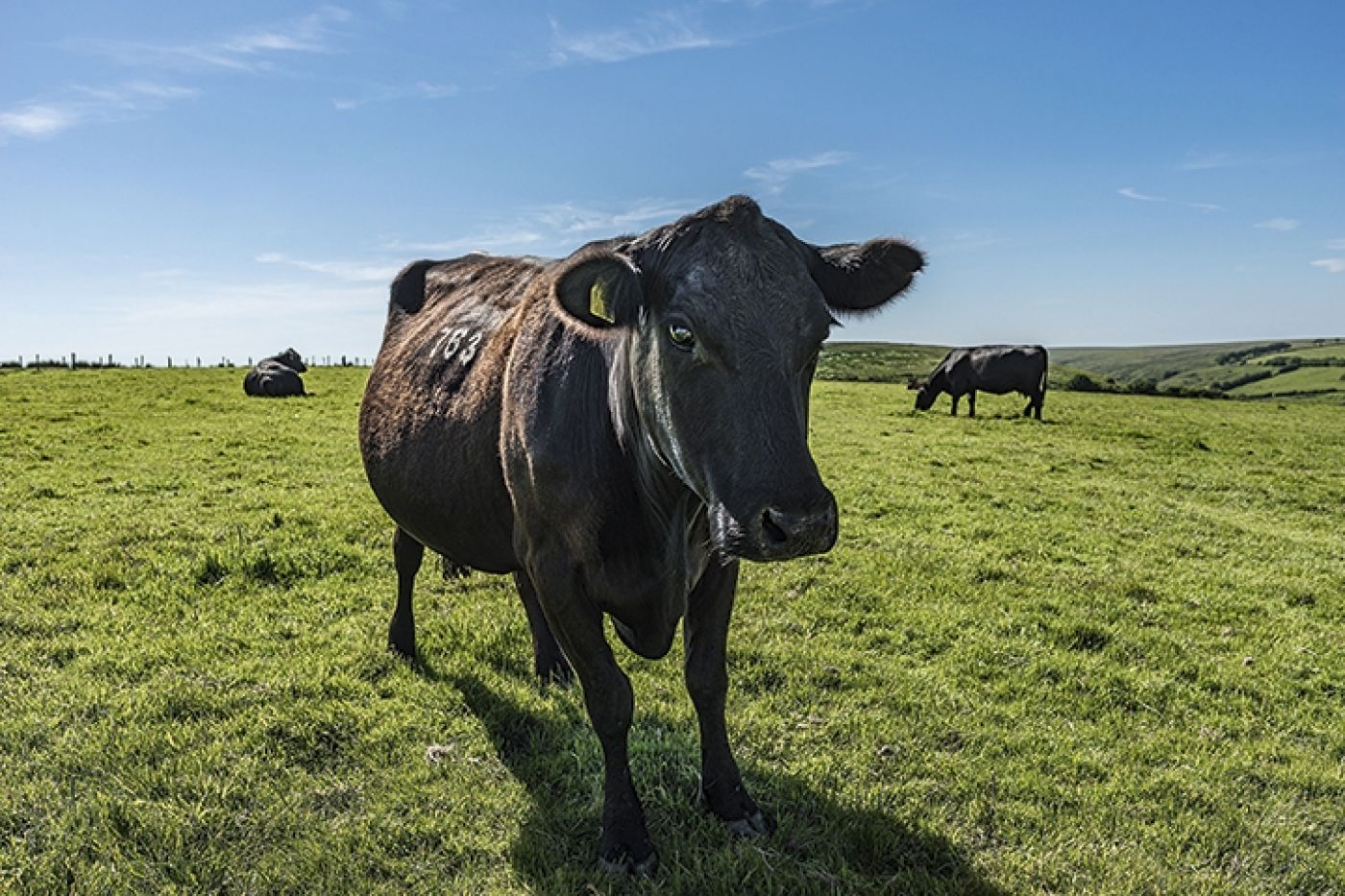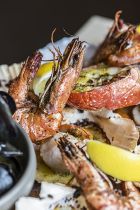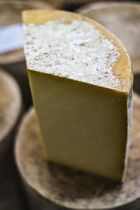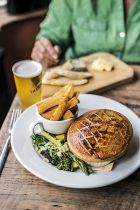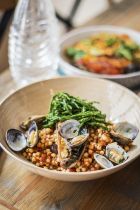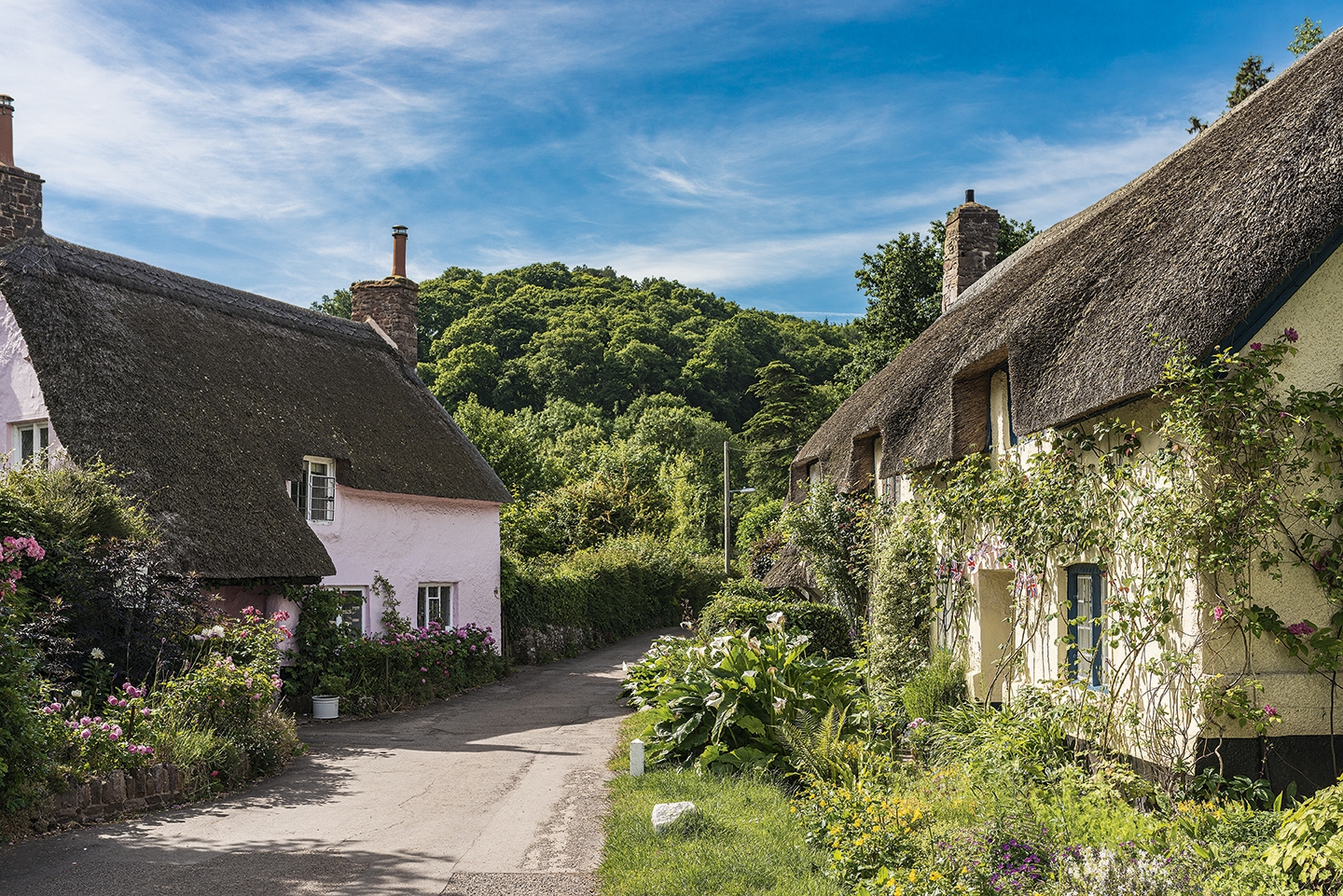
Food and Travel Review
Their first mistake, they admit, was to leave a boar in the pen with the sows. ‘The result? Sixty piglets in one week.’ Pam and Andy Barr, owners of Little Oak Farm in Exmoor National Park, smile rather ruefully at this memory as they eye their two fine, 280kg boars and four slightly less-hefty sows in the large, open-air pen in front of them. The animals have an appealing gingery hue: ‘Oh, that’s because of the mud they love to wallow in,’ says respected breeder Pam. ‘They are in fact creamy-white, as befits their breed, Middle Whites. We love them – they’re so ugly they’re beautiful.’
You couldn’t really argue with that. With their tiny eyes and small, flat snouts, these rare-breed pigs are unlikely to win a beauty contest, but their contented cheerfulness has a beauty of its own. So too does their meat. ‘We let our sows breed only twice every three years, so they retain their fine flavour,’ says Pam. ‘The butcher is nearby and our pork, bacon and sausages travel only a few miles from here to local restaurants, hotels and markets.’ Upbringing counts when it comes to the quality of the meat too: ‘Our piglets spend their first 10 weeks with their mum, giving them a good start in life,’ she says. ‘Mum is pretty fed up by then – the moment she’s able to leave the pen, she’s out of it as fast as her legs can carry her.’
This century-old Yorkshire breed has found a good home here, high on the edge of Exmoor, a designated Area of Outstanding Natural Beauty and one of the least-populated regions in England. Most of the moor lies within Somerset, a large county with a hugely
varied landscape stretching from the Dorset border in the east to the wild uplands of the South West. Further into the national park – reached via the kind of high-banked, narrow, twisting lanes that make you wish you could see around corners – father and son Oliver and David Edwards live on an isolated, 200ha, 515m high, working hillfarm. It’s an idyllic spot, with a lovely old farmhouse lying alongside a wide, shallow stream. But farming here isn’t for the faint-hearted.
‘We have a closed herd,’ David explains. ‘We replace our own heifers and bulls and can trace each one’s parentage. The behaviour of farm animals is fascinating, and it’s very important to understand it.’ Reassuring for any visitor who finds themselves surrounded by this impressive herd of Angus cattle: cows, heifers, calves and a bull, an animal most of us only ever view from behind a sturdy gate. But standing among these very handsome animals in this glorious environment is a marvellous experience. On a clear, sunny day, you can see far across Exmoor. Although, sighs David, ‘Come up here in winter when the Atlantic gales are blowing, for a very different experience of hill-farming.’
Driving back down into the farm’s tree-shaded valley, across cattle grids, past low, moss-covered, stone walls, sheep can be seen trailing down to the stream in anticipation of a drink, and a noisy gaggle of geese passes overhead. In this pastoral splendour it’s easy to forget our good food producers also have to spend their time tackling biodiversity loss and soil depletion; they know that the quality of their produce starts with the soil.
Supply chains too can be a problem. A few miles east, venison farmer Peter Hurman has the answer. ‘We sell in farmers’ markets. Unlike chefs, who want only a couple of specific cuts, shoppers like them all, and also want to know where the animal is from, what it has fed on. Local people share their old family venison recipes with me too – pies, stews, soups. I love to talk with them,’ says Peter, who was once a dairy farmer. When asked why he farms an animal that is plentiful in the wild here, he explains, ‘You don’t know what you have when you shoot a wild deer – its age, feed or breed. I have red deer and they feed on this healthy, red-sandstone pasture; there’s a small abattoir nearby so I’m sure of the meat that I sell.’
Moving across the gently-sloping, wooded hillside, closer to his curious, graceful herd, he adds, ‘You need patience to breed deer. If you drive them somewhere, they do the opposite and if one escapes, you have to outsmart them. In late summer, the stags swagger around, proud of their beautiful, velvety antlers and in October they rut and make a mighty noise about it.’
West Somerset is a region of contrasts: in the east, the Quantock Hills’ oak woods and ancient parklands and the Somerset Levels’ mist-shrouded wetlands support a richly diverse wildlife. Apple orchards, dairy farms and market gardens thrive on the fertile land and hills leading westwards towards the heather, gorse and heath of Exmoor. Tapering, wooded valleys filled with fast-running streams criss-cross the moor, some flowing to the
55km coastline of small, secluded beaches and dramatic, rugged cliffs on the Bristol Channel. One of them, at 410m, is the highest in England. There are rose-covered, thatched cottages prettier than any found on chocolate-box lids, and picturesque churches with cemeteries and a yew trees, those arboreal sentinels of death. Villages, hamlets and once-flourishing fishing communities are home to distinctively local, and often very old, pubs; and in medieval Dunster, an imposing Anglo-Saxon castle overshadows a village built with wealth from the cloth trade.
'You need pateince to breed deer. If you drive them somewhere, they do the opposite and if one escapes, you have to outsmart them. In late summer, the stags swagger around'
This resplendent scenery, long-imbued with a colourful history, has inevitably attracted writers. Evelyn Waugh spent his later years in Combe Florey; TS Eliot’s soul rests in East Coker and RD Blackmore’s Lorna Doone – a novel of raw passion, dastardly deeds and high drama – takes place on Exmoor; and William Wordsworth wandered the Quantocks accompanied by Samuel Taylor Coleridge, who wrote The Rime of the Ancient Mariner while he lived in Nether Stowey. And, looking out over the Bristol Channel from East Quay, an innovative, modern addition to 18th-century Watchet harbour, it’s easy to imagine the scene that Coleridge would have witnessed: great schooners passing on their way from Bristol to the Atlantic Ocean where, in full, magnificent sail, some would have crossed the equator to the Southern Seas and the world of the fabulous albatross.
Along from Watchet, the moor descends to the water’s edge to surround attractive, north-facing Porlock Bay, where oyster fisherman Ian Kershaw is hard at work. The tide is out, which means that he is bouncing over the pebbles and small boulders in his workman-like beach buggy to get out to the oyster beds, having checked the tide – at 9.5m, one of the highest in Europe – isn’t due back any time soon. Ian stops at one of his metal-frame ‘beds’, set a half-metre above firm sand, and hoists a huge wire-bag of oysters over his shoulder.
‘At least I don’t have to worry about feeding them,’ he says as he loads the bag on to the buggy. ‘Their food comes from the water; they are surrounded by seaweeds and the clean Atlantic tide washes over them twice a day.’ These firm, deliciously-briny, Pacific oysters – smaller, hardier and more reliable than native ones – take three to four years to mature, and Ian regularly checks their progress and comfort.
The same strong tide is responsible for one of the wonders of the natural world – the migration of eels between the low-lying Somerset Levels and the North Atlantic’s Sargasso Sea. Although fished sustainably here, eels have become endangered due to their commercial popularity elsewhere. Twenty years ago, mastersmoker Jesse Pattison took over the small, purpose-built Brown and Forrest Smokery near Langport.
‘Eels, those strange creatures, they fascinate me,’ he explains. ‘I admire the skill needed to catch them and appreciate their sweet, rich flavour and coppery-gold skin when hot-smoked – skin-on, to keep them moist – over a beechwood fire, a wood best-suited to their delicate flavour. I cold-smoke foods too, but I cure these first – with a brine-not-salt cure – as cold-smoking requires lots of smoke but no heat or flames.’
However, in order to ensure sustainability, it isn’t possible to keep eel on the menu permanently, so Jesse also uses his heavy, wardrobe-sized metal smoker to preserve fine-quality products such as trout, haddock, salmon, duck and cheese. He’s particularly proud of his smoked pork from a nearby farm that is cured in cider and cider brandy from Burrow Hill, a few miles north. The area’s sandy-loam soil and generous rainfall provide the perfect terroir for apples – one of the reason that cider production here, on the edge of the Somerset Levels, is a millennia-old tradition. Internationally-renowned Burrow Hill Cider produces old-style, local cider – made with two-thirds sour apples and onethird sweet – plus single-varietal ciders and a fine, pale-amber cider brandy made in the comely bulges and protruding pipes of two handsome, albeit temperamental, copper stills named Josephine and Fifi. In this corner of apple paradise, owner and farmer Julian Temperley has protected and restored over 100 varietals, and his well-produced ciders are a perfect fit for the work of local craft-food makers, especially the cheesemakers.
Cheddar cheese and a flagon of cider is a marriage made in gustatory heaven. At least it is when the cheese is traditionally and handmade from the unpasteurised milk of pasture-reared cows, and the cider is of equal stature. Jamie Montgomery’s family have been making cheese in this way on their 485ha Manor Farm in nearby North Cadbury for over a century
‘There’s a pool of cheesemaking knowledge here that’s unrivalled,’ says Jamie. ‘To start the process you need rolled, or stored, whey – the liquid that separates out from milk curds. On raw-milk farms, different starter-wheys are used on different days to avoid unwanted viruses causing contamination [so if one is affected you only lose that day’s batch] – which is one reason cheeses made on the same farm with milk from the same cows can vary so much in taste. This is a complex process and older cheesemakers learnt everything they knew from their powers of observation. I do the same.’
Nearly 30 years ago, the inestimable Randolph Hodgson, of London’s Neal’s Yard Dairy, tasted Jamie’s rich, nutty cheddar, and since then, it has picked up a barrow-full of national and international awards. ‘My mother taught me most of what I know about cheesemaking,’ Jamie says, standing in his storage area, surrounded by shelves stacked-high with magnificent, 25kg cheeses maturing for six, 12 and 18 months.
'Cheddar and a flagon of cider is a marriage made in gustatory heaven. At least it is when the cheese is handmade from the unpasterurised milk of pasture-reared cows'
‘This area’s farms are seasonal and there’s a peak and a trough in milk production, so sometimes there weren’t enough cheese presses for the quantity of milk produced. This is why we cloth-bind cheeses here, rather than cave-ageing them, wrapping bandages
around them to stop them collapsing. This also creates a drier environment for the cheese to ripen and breathe and results in a better taste, a umami flavour. Storage is very important for the cheeses’ flavour, and that can’t be manufactured.’
One chef who appreciates the knowledge and skills of local producers is Somerset-born Andrew Swann, executive head chef of Brazz at The Castle Hotel, Taunton, a historically-rich town close to the Quantock Hills. He follows in the culinary footsteps of chefs
Chris Oakes, Gary Rhodes, Phil Vickery and Richard Guest, who all practised ‘farm to table’ in the kitchens of this family-owned hotel long before the idea became modish.
‘If a local, organic, small producer approaches me with a good product, I’m interested,’ explains Andrew. ‘This area is everything I first fell in love with 20 years ago.’ In saying this, he encapsulates what awaits any visitor to West Somerset – laudable care for livestock, the producers’ respect for traditional knowledge – and echoes the ethos of Jesse Pattison. ‘There’s an honesty about Somerset; “local” means something here, there’s integrity,’ says Jesse. ‘When you see the beautiful grass here, you feel differently about your food – these are farmers who care about the soil. We’re not about haute cuisine, although we have very fine food. We’re welcoming and that’s why I like being here.’
Words by Rosemary Barron. Photography by Gary Latham.
Rosemary Barron and Gary Latham travelled to Somerset courtesy of Visit Somerset. visitsomerset.co.uk
Where to stay
The Castle Hotel Owned by the Chapman family for three generations, this centrally located, welcoming hotel in Taunton has 44 guest rooms. A traditional or champagne afternoon tea in the hotel’s fine, art deco drawing room makes a fitting end to a day exploring the nearby Quantocks or Exmoor, less than an hour’s drive away. Breakfast dishes include smoked haddock, porridge, sausages, bacon, seasonal vegetarian options, locally made jam and a variety of egg dishes. Doubles from £133. Castle Green, Taunton TA1 1NF, 01823 272671, the-castle-hotel.com
The Luttrell Arms Hotel Thought to have inspired the setting for one of Thomas Hardy’s novels – and it isn’t hard to believe standing in the bar, lounges and outdoor terraces of this 28-room hotel on the village’s wide medieval, high street. Antique furniture fills the guest rooms and some have a private terrace. Dunster Castle, where the Luttrell family lived for 600 years, lies within easy walking distance. Breakfast on kippers, local sausages and bacon, eggs, fresh breads and local jams, and stay on for lunch or dinner served in Psalter’s restaurant housed in the historic dining room – ham hock and pea terrine or West Country cheese ploughman’s for lunch, perhaps, and fish pie with garden greens or Torbay sole with caper butter for dinner, washed down with an extensive wine list that includes South African and Spanish red, an Italian rosé, and dessert riesling and port by the glass. Doubles from £238, including breakfast. 32-36 High Street, Dunster TA24 6SG, 01643 821555, luttrellarms.co.uk
The Royal Oak Inn A 14th-century inn with flagstone flooring, open beams, stone walls, and nine guest rooms, tucked away in the tiny Exmoor National Park village of Luxborough. Owner Spencer Braydon-Phillips serves a good selection of real ales in the atmospheric, low-ceilinged bar that’s also a popular local watering hole. A hearty and generous breakfast buffet includes local breads and cheeses, yoghurt, fruits and honey, with savoury and egg dishes made to order. Doubles from £120, including breakfast. Luxborough, nr Dunster TA23 0SH, 01984 641498, royaloakinnluxborough.co.uk
Westermill Farm Bring your own tent and camp in meadows beside the lovely River Exe, in Exmoor National Park. Or stay in one of six eco-friendly, self-catering cottages, sleeping up to eight, in this peaceful, secluded valley with its 200ha moor and grassland working hill-farm. Campers and cottage guests have private access to 3km of the river; children and dogs are welcome. Camping, £12.50pp; cottages from £454 for three nights. Exford, Near Minehead TA24 7NJ, 01643 831 238, westermill.com
Travel Information
Located on the southern shore of the Bristol Channel, West Somerset is a district of contrasts, with moors and wooded valleys, including the Quantock Hills, and a large part of it lies within Exmoor National Park.
GETTING THERE
Great Western Railway The train is the fastest way to travel from London, at around two hours from Paddington to Taunton. It’s around three hours by road from London, or around one hour from Bristol. gwr.com
GETTING AROUND
By road As well as a core bus network, the Adventures by Bus service offers open-top tours within Exmoor National Park and beyond. firstbus.co.uk
RESOURCES
Visit Somerset has information on the region’s produce, history, architecture, activities and beaches. visitsomerset.co.uk
Visit Exmoor helps you plan walking trails and cycling routes and also has a directory of food and drink producers. visit-exmoor.co.uk
Where to eat
Prices listed are per person for two courses excluding drinks, unless otherwise stated
Brazz Executive chef Andrew Swann sources most of his ingredients from producers close by, including a 24-month, aged cheddar from Montgomery’s Cheese, Quantock lamb, and potatoes from a farmer who grows 34 varieties. Expect starters like smoked salmon with pickled beetroot and dill mayonnaise or crab pâté with samphire; mains might be turbot with hot tartare sauce, Somerset free-range chicken, beef grills, and burgers with seasonal salads and side dishes, while desserts include fruit sorbets, poached rhubarb and custard tart. A well-considered wine list includes wines from one of Greece’s finest winemakers and a limestone-grown chardonnay from nearby Langport. Brunch from £11; dinner from £23. Castle Green, Taunton TA1 1NF, 01823 272671, the-castle-hotel.com
Brown and Forrest Smokery The smokery has a casual, friendly and spacious café serving plates with fresh salads and crusty breads, sandwiches, quiches and enticing cakes alongside a neat selection of wines, ciders, beers and alcohol-free drinks. There are plenty of picnic benches outside to use in good weather or you can order a takeaway to enjoy in the beautiful surrounding countryside. Smoked foods from the on-site smokery are also available in the shop or by mail order (as well as at Fortnum & Mason and other fine food retailers). Booking recommended. Filled baps, £5.25. Bowdens Farm, Hambridge Road,
Langport TA10 0BP, 01458 250875, brownandforrest.co.uk
East Quay Kitchen Music, poetry, arts and family events take place in this modern, innovative, harbourside building run by social enterprise Onion Collective. In the ground-floor café, head chef Richard Pettitt sources locally and seasonally for his Turkish- and Middle Eastern-inspired, mainly vegetarian, menu. Breakfasts feature granola with mixed berries, shakshuka eggs, and tahini mushrooms on sourdough; for lunch, try spicy butternut squash wrap, Turkish lamb and vegetable stew or griddled courgettes on lentils. Snacks, coffee, ice creams and cakes too. Breakfast from £6; lunch mains from £8.50. Watchet Harbour,
Watchet TA23 0AQ, 01984 263103, eastquaywatchet.co.uk
The Porlock Weir Hotel In this comfortable hotel on the quay of a tiny, attractive harbour, South African-born chef Miguel Tenreiro likes, if possible, to catch the fish he serves, or he sources from Brixham, the closest fish market. Oysters are, literally, at his doorstep, he forages samphire from the surrounding cliffs and grows an edible garden – flowers and herbs – outside his kitchen’s back door. In the airy and light-filled dining room overlooking Porlock Bay, you might begin with cured sea trout and pickled red cabbage or black pudding Scotch egg and apple sauce; mains include roasted sea bass fillet and pea risotto, Little Oak Farm pork belly with heritage beetroot, or whole, grilled catch of the day. An attractive wine list includes options from France, South Africa, Italy and Portugal. From £32. Porlock Weir TA24 8PB, 01643 800400, porlockweirhotel.co.uk
The Ship Inn This large,13th-century coaching inn, understandably popular with visitors to the area since it’s one of the oldest on Exmoor, is a Free House with ciders and cask ales on tap, including Exmoor Ale. In summer, lunch on ploughman’s, soup or a crab mayonnaise sandwich on its attractive outdoor terraces, while in winter log fires keep the large, stone-floored rooms cosy. The dinner menu includes venison steak, grilled mackerel with beetroot purée and beer-battered cod fillet, and there’s a Sunday roast too. A few rooms are available on a B&B basis. Dinner reservation recommended in high season. From £18.50. High Street, Porlock TA24 8QD, 01643 862507, shipinnporlock.co.uk
Woods Bar and Restaurant Owners Paddy Groves and Sally Harvey produce the lamb and pork chef Ed Heard prepares on their own farm nearby. Other local producers keep up a steady supply of quality, seasonal foods to this attractive, popular neighbourhood restaurant. The frequently changing menu might feature goats’ cheese mousse with pickled walnuts, seared scallops with samphire and lemon butter, honeyroast ham with chunky-chip potatoes or slow-roast loin and shoulder of Northcombe lamb with heritage carrots. Leave space for homemade malt, stem ginger, or rhubarb ice cream. An extensive, well-priced wine list includes a Lebanese Bekaa Valley red and a Washington State white. Closed Sundays and Mondays. From £27. 4 Bank Square, Dulverton
TA22 9BU, 01398 324 007, woodsdulverton.co.uk
Food Glossary
Get Premium access to all the latest content online
Subscribe and view full print editions online... Subscribe


